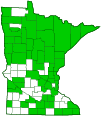Sinewed Bushy Lichen
(Ramalina americana)
Conservation • Description • Ecology • Distribution • Taxonomy
Conservation Status |
|||
| IUCN Red List | not listed |
||
| NatureServe | NNR - Unranked |
||
| Minnesota | not listed |
||
Description
Sinewed Bushy Lichen is widespread and very common. It occurs in the eastern deciduous forests of the United States and southern Canada, and in the mountainous forests of Mexico. It is very common east of the Great Plains. There are just a handful of reports in the west and those are likely a due to transport by humans. In Minnesota it is very common in the north, scattered to absent in the south. It is found on bark of old hardwood trees, usually in full sun, mostly on twigs and branches in the upper canopy but also on the trunk. It gets moisture from the air and rain, and nutrients from debris that accumulates around it (epiphytic). It is more sensitive to air pollution than most lichens, and is absent from areas with even mild air pollution.
Ramalina americana is a species complex formerly with three forms (morphs); americana morph, asahinae morph, and sayeana morph. The americana morph, the only morph found in Canada and the United States, was previously thought to be the European species Ramalina americana. It was recognized as a separate species in 1978.
Sinewed Bushy Lichen appears as a short, shrubby (fruticose) tuft that is usually ⅜″ to 13 ⁄16″ (1 to 3 cm) wide, sometimes a little wider. The tuft is a cluster of numerous individual fruiting bodies (thalli). Each thallus is narrow, straight-sided (linear), strongly flattened, sparsely branched, and often lobed. It is yellowish-green, 1 ⁄64″ to ⅛″ (0.2 to 3 mm) wide, and strongly ridged and channeled. It is solid in cross section all the way to the base. It is neither warty nor perforated. The upper surface (cortex) has numerous minute, white, openings (pseudocyphellae) that are raised or level with the thallus surface, not depressed into it.
Yellow, disk-like, spore-producing structures (apothecia) are frequent and large. They appear at or close to the tips of the branches. They are usually flat but often contorted.
Similar Species
Ecology
Substrate
Trees
Growth Form
Fruticose
Habitat
Full sun
Hosts
Distribution |
||
|
Sources Biodiversity occurrence data published by: Minnesota Biodiversity Atlas (accessed through the Minnesota Biodiversity Atlas Portal, bellatlas.umn.edu, 12/31/2024). |
|
| 12/31/2024 | ||
Occurrence |
||
Widespread and very common |
||
Taxonomy
Kingdom
Fungi (Fungi)
Subkingdom
Dikarya
Phylum
Ascomycota (Sac Fungi)
Subphylum
Pezizomycotina (Sac Fungi and Lichens)
Class
Lecanoromycetes (Common Lichens)
Subclass
Lecanoromycetidae (Shield Lichens, Sunburst Lichens, Rosette Lichens, and Allies)
Order
Lecanorales (shield lichens, rim lichens, and allies)
Suborder
Lecanorineae
Family
Ramalinaceae (bushy lichens, sea-fog lichens, and allies)
Genus
Ramalina (bushy lichens)
Mycobiont
Ramalina americana
Photobiont
Subordinate Taxa
Synonyms
Common Names
American Cartilage Lichen
Sinewed Bushy Lichen
Sinewed Ramalina
Glossary
Apothecium
An open, disk-shaped or cup-shaped, reproductive structure, with spore sacs on the upper surface, that produces spores for the fungal partner of a lichen. Plural: apothecia.
Fruticose
Shrubby: referring to the growh form of lichens that may be tufted, draped, or stalked.
Linear
Long, straight, and narrow, with more or less parallel sides, like a blade of grass.
Thallus
The vegetative body of a lichen composed of both the alga and the fungus.
Visitor Photos
Share your photo of this lichen.
This button not working for you?
Simply email us at info@MinnesotaSeasons.com.
Attach one or more photos and, if you like, a caption.
Luciearl |
||
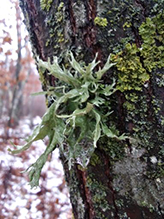 |
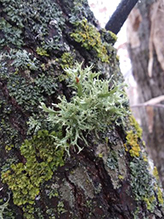 |
|
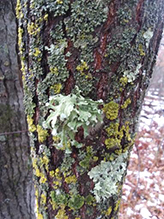 |
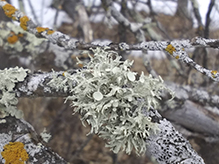 |
|
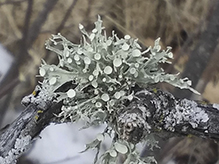 |
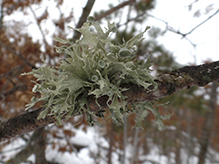 |
|
|
Found on oak branch. |
|
lichen found on dead oak branches |
||
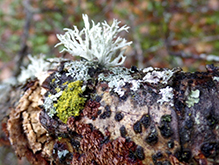 |
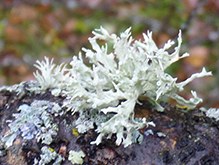 |
|
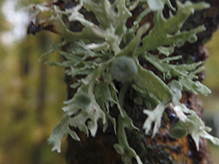 |
||
MinnesotaSeasons.com Photos
|

Slideshows

Visitor Videos
Share your video of this lichen.
This button not working for you?
Simply email us at info@MinnesotaSeasons.com.
Attach a video, a YouTube link, or a cloud storage link.
Other Videos

Visitor Sightings
Report a sighting of this lichen.
This button not working for you?
Simply email us at info@MinnesotaSeasons.com.
Be sure to include a location.
MinnesotaSeasons.com Sightings |
|

